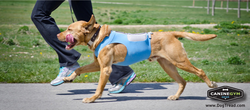 Sustained trotting is GREAT for dogs that are older than one year old, in good health and not over-weight. If your dog is overweight, care needs to be taken with duration and surface. 90% of extra weight is caused by the food/treats or how much food/treats you are feeding your dog. Adjust calorie intake and increase exercise slowly to minimize the stress on your dog’s joints. Benefits of sustained trotting · increases endurance, · improves physical health, · keeps the lumbar area loose and your dog’s hips rotating independently · lengthens and strengthens the spine · strengthens core muscles · improves gait function · mentally challenges the dog Definition of a Balanced Trot: “This is a rhythmic two-beat gait in which diagonally opposite legs move together i.e., right hind with left front, left hind with right front. Because only two feet are on the ground at a time, the dog must rely on forward momentum for balance. A balanced trot shows an almost imperceptible delay in the diagonal rhythm as the forepaws land gently, minimizing impact as the front assembly absorbs drive from the rear”. Reference: Dog Steps A New Look, by Rachael Page Elliot, Published by Doral Publishing, Inc. (2001) pg. 11 & 31 Definition of Sustained: “maintained at length without interruption or weakening” Reference: http://www.thefreedictionary.com/sustained Before starting any type of sustained trot work, I recommend warming up your dog’s major joints as well as feet and toes. After warming up your dog’s joints, I recommend a light trot for 3-5 minutes before starting sustained trot work. Light Trot = slowest trot you can achieve before walking, ambling or pacing. The recommendation is 20 minutes of sustained trotting three times a week. See schedule below for building up slowly over time. Here are some ways you can trot your dog and a planned schedule to build endurance: Treadmill use: If purchasing treadmill, look for the right length of treadmill to accommodate your dog’s stride length. I have found that many dog treadmill manufacturers are recommending the medium size treadmill for the medium sized dog, but the tread length is not always long enough for many of these 40-60 lb. dogs. Please take into consideration your dog’s leg and stride length when ordering. I always recommend the longer tread length if there is any question about whether or not the tread is long enough. Make sure you are looking at the TREAD length or RUN SURFACE not the full length of the machine. Human treadmills are NOT long enough for a 40-50 lb. or bigger dog. Using a human treadmill can shorten your dog’s stride and cause compensations in the neck, back and limbs. If using a treadmill you want to make sure it is long enough so that it will not shorten your dog’s rear stride – this is bad for the lower back and hips and causes compensations that can lend to injury. Generally for a dog over 30 lbs., a treadmill’s running surface needs to be 6 feet long depending on the stride length of the dog. It is important to make sure your dog is not dog trotting near the back or the front of the tread so that the full length of their stride can be achieved. I personally recommend DogTread treadmills. Please see their website for details. Here is a great article on the benefits of treadmill running. Check it out!! https://dogtread.com/benefits-of-treadmill-running-for-dogs/ Human Jogs and Dog Trots: Unless you have a tiny dog, most humans will have to jog or walk really fast to get their dog to a trotting speed. I recommend using a leash with harness that does not restrict forward movement of the front limbs instead of any type of collar. Jogging with your dog is an excellent option because you and your dog are working together. What could be better? Biking: This typically means a slow bike ride for the human in order to keep the dog at a trot. I recommend purchasing a bike attachment to insure you and your dog’s safety while trotting. Most bike attachment have a lead that fixes to the dog harness and I truly recommend also attaching a lead to the dog’s collar or harness that you can hold onto. Teaching your dog directions cues (right and left) so that you can indicate a direction change before the turn is also very handy. This will keep the dog moving smoothly and eliminate any confusion. Use the following schedule to increase trotting time to build up to 20 minutes 3 times a week. This schedule is very conservative. I put this schedule together for my K9 Conditioning clients who are also working on performance, strength training and improved weight distribution. This schedule will work for most healthy active dogs and was designed with all surfaces in mind (treadmill, pavement, dirt, etc). As with any exercise program, it is recommended to consult with your Veterinarian prior to starting endurance, strength or balance exercises. Schedule: Start with 3-5 minute slow trot (slowest speed you can go and still get a trot) to warm up and cool down is needed with each trotting session. So when factoring in the warm up trot, your 5 minute sessions are really closer to 15 minutes, 10 minute sessions are close to 20 minutes etc. This is a very conservative schedule designed so that your dog does not get overly sore and is built up gradually. Step 1: a. Warm up exercises to warm up major joints, feet and toes, each time before trotting b. 3-5 minute slow trot c. 5 minutes sustained trotting d. 3 times a week e. 5 sessions before moving on to Step 2 Step 2: 10 minutes, 3 times a week, for 10 sessions f. Warm up exercises to warm up major joints, feet and toes, each time before trotting g. 3-5 minute slow trot h. 10 minutes sustained trotting i. 3 times a week j. 10 sessions before moving on to Step 3 Step 3: 15 minutes, 3 times a week, for 15 sessions k. Warm up exercises to warm up major joints, feet and toes, each time before trotting l. 3-5 minute slow trot m. 15 minutes sustained trotting n. 3 times a week o. 15 sessions before moving on to 20 minute sessions Work up to 20 minutes 3 times a week (it will take approximately 10 weeks). This schedule will acclimate your dog to the trot speed gradually and for sustained periods of time. It is OK to trot on pavement as long as the dog is over a year old, and you are not trotting longer than 20 min, 3x a week. For most dogs this is 1.5-2 miles. SUSTAINED WALKING OR TROTTING FOR A PUPPY The rule of thumb for walking puppies on hard surfaces for sustained periods of time 5 minutes for every month they are old until their growth plates close. Before growth plates close, if you walk or trot a dog for sustained periods on hard surfaces longer than recommended, you can cause stress fractures in their bones that require surgery and could cause their gait to be off for life. Puppies love to fight, wrestle, and romp around in play and typically puppies are good at self-regulating that behavior and stop and rest when they need to. Sustained walking or trotting is typically maintained by the handler. It is important to learn the signs of fatigue and allow for rest. I feel strongly that exercising a puppy should be both mental and physical so incorporating trick training, play, leash walks, and body awareness exercises is a great way to keep your puppy active. Please let me know if there are comments or questions. See my web link below to sign up for quarterly email updates. Bobbie Lyons Email: pawsitiveperformance@yahoo.com Website: http://www.pawsitive-performance.com/services.html Flyball is a sport that has many physical demands. These dogs need a regular routine of strength, body awareness, flexibility and coordination training to prepare their body for action. Some of the traits needed to compete in Flyball are listed below:
1. SPEED 2. The ability to jump with extension 3. Good strength through the spine and ribcage 4. Turning power 5. Shoulder strength, stability and flexibility In order to decrease the chance of injury, the dog needs to use the “right” muscles and have the proper flexibility. I often hear from handlers that their dog is well muscled. That may be true but is the dog engaging their stabilizer muscles around the joints or are they over using a muscle group that leaves another muscle group weaker? This is a common problem and lends to injury. Developing a warm up strategy for your dog will decrease the chance of injury and improve your dog’s performance. Paying close attention to warming up all major joints starting with toes and feet is good practice. If a dog doesn’t use his feet and toes properly while absorbing the impact at the box, the energy will transfer to the shoulder. Soft tissue shoulder injuries are very difficult to diagnose and rehabilitate. If you are unaware of how to develop a proper warm up routine, seek guidance. ACTIVE stretches are OK but NO static stretches until after activity. Stretching a muscle prior to activity DECREASES the power of the muscle. Best time for static stretches is at home, after a walk when your dog’s muscles are warm and your dog can relax into each stretch. Active stretches = Range of motion but not held more than 1-2 seconds Static Stretches = Slowing increasing range of motion while holding the stretch for 30 seconds. For Flyball dogs, lengthening and strengthening through the spine and ribcage is so important due to the compression that happens when the dog hits the Flyball box. Strengthening the muscles along the spine, lower abdominal muscles and muscle that control the hips (Iliopsoas) will help the dog’s body manage that compression. I recommend cavaletti training to improve stride, lengthen and strengthen through the shoulders, spine, ribcage, core muscle group and hip flexors to many of my performance dog clients. Getting some guidance on spacing between the poles and height of the poles is essential. Remember, you CAN do harm if you are not doing exercises correctly. Lack of body awareness or proper weight distribution is another area of concern. I see many performance dogs every week that have no idea that there is anything beyond their shoulders. Many have done a lot of rear foot targeting, which is GREAT in moderation but rear foot targeting teaches the dog to put 95% of their weight forward on their shoulders. This may mean that your dog knows where his back feet are but it does NOT teach the dog to put weight on those feet. Instead it teaches them to rely solely on their shoulders. For a Flyball dog, this is not ideal. Correctly using inflatable FitPAWS props or other rehab equipment can encourage the dog to shift their weight forward and backward as well as side to side to engage the proper muscle groups that lend to stability and improved performance. Get some guidance from a canine fitness coach, rehabilitation expert or physical therapist to ensure you are encouraging proper muscle engagement and body position to maximize each exercise. Spending 10-15 minutes three times a week on a strength and stretching routine is all that is needed. Remember, you are training an athlete not a couch potato. A side note on weight: By keeping your dog the ideal weight, the dog’s speed and accuracy in movement will be ideal. It is five times the dog’s weight on their shoulders every time they land a jump and I can’t begin to understand the force absorbed by the body at the Flyball box (depends on so many things). For the health of your dog’s joints, it is super important to keep your dog at an ideal performance weight. Bobbie Lyons Cert CF pawsitiveperformance@yahoo.com In the human world the term “cross-training” is used quite often to suggest that doing different types of strength, balance and coordination training helps to improve performance. The canine world works much the same way.
Canine conditioning or cross-training exercises are a great way to keep your dog in shape, encourage weight loss, maintain current weight, keep your dog mentally and physically challenged and reduce the chance of injury through strength, flexibility and weight distribution training. Participating in K9 Conditioning or fitness exercises just 10-15 minutes 2-3 x a week can go a long way to improving your dog’s stability and performance. When you are training and developing a dog’s skills, canine strength training HAS to be part of your program if you are interested in participating in performance sports long term and without injury. Your dog’s structure, confidence on equipment, speed in which they are traveling, awareness of their rear legs, how to efficiently use their core and STRONG supporting muscles around their joints all play a part in keeping your dog in the game. Some of the ways you can participate in “cross training” your canine athlete: · Learning a proper warm up and cool down strategy to improve joint mobility before exercise or performance · The use of FitPAWS inflatable equipment for strength and balance training. Knowing correct body position is important to maximize the benefits of using this type of equipment. · The use of Canine Gym equipment such as the K9FITbone, K9FITVest (weighted or cooling) and the K9FITTug · Trick training for balance and coordination – body position is again very important here. · Using a Dog Tread Treadmill for sustained trotting to build endurance · Cavaletti training – spacing between the poles and height of poles are very specific for improving gait and forelimb and hindlimb reach. · Swimming your dog, straight, and turning in both directions and using all four limbs · Flexibility training - stretching It is our job as handlers to go the “extra mile” and learn how to design a program for our canine athletes. If you are unsure of what to do, seek advice from someone who knows. Check out my online classes (enrolling NOW) to find out more about K9 Conditioning and how I can help you design a program for your dog. I offer in-person private lessons in the Portland, OR area AND ONLINE private lessons through video exchange. Bring K9 conditioning to your town by scheduling a workshop. Contact me today to learn more. Bobbie Lyons, Cert CF pawsitiveperformance@yahoo.com |
AuthorBobbie Lyons, CCFT, KPA CPT Archives
April 2019
Categories |

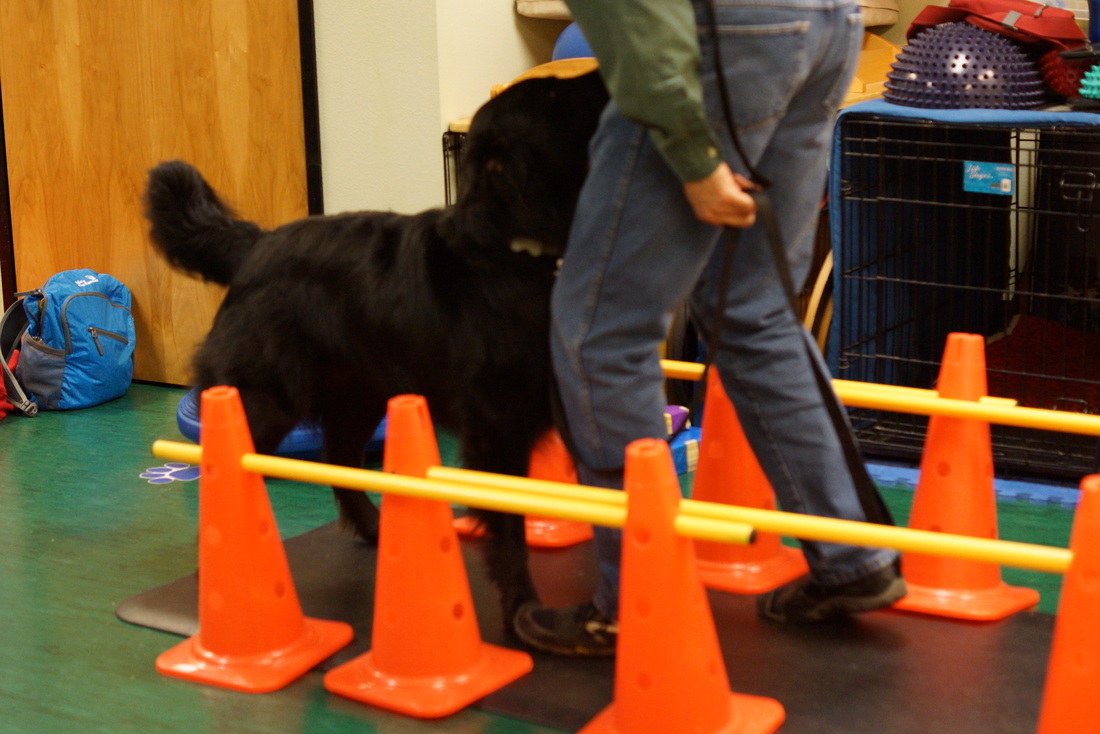
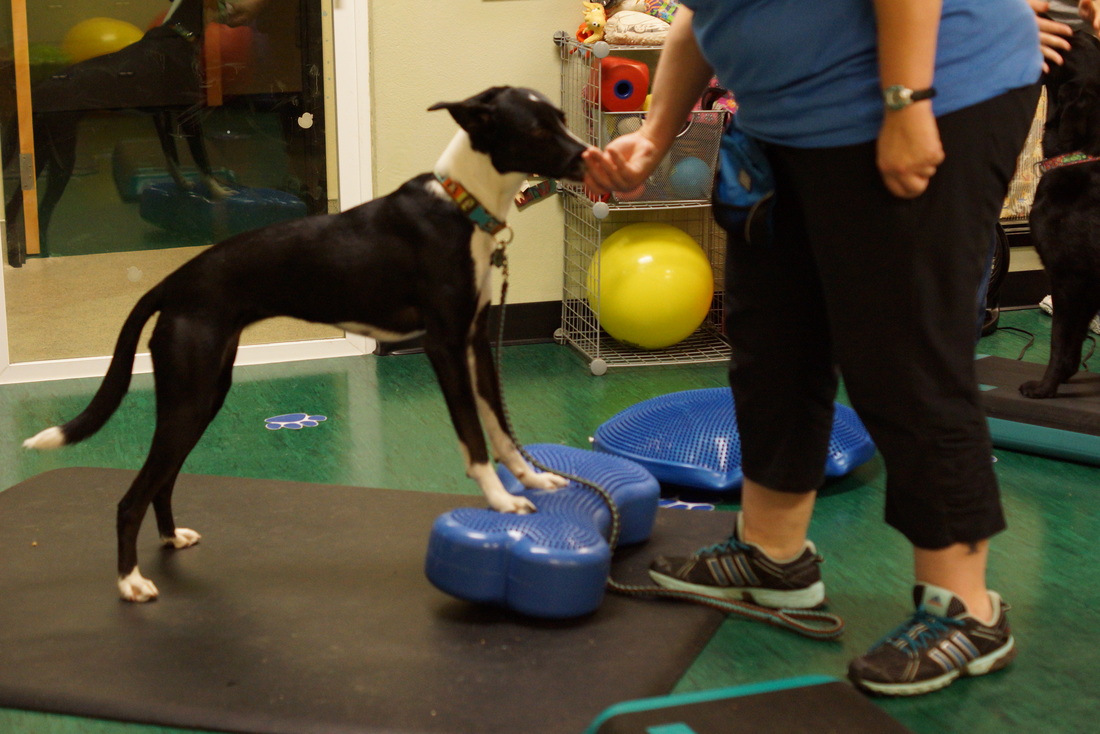
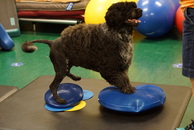
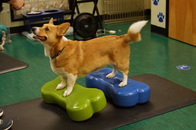
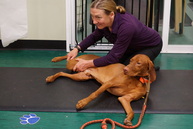
 RSS Feed
RSS Feed